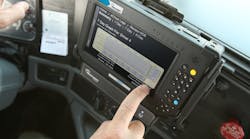Given that mandatory electronic logging devices for drivers’ hours-of-service compliance has been a priority for the American Trucking Assns. (ATA) for several years, it’s not surprising that ATA has welcomed the Federal Motor Carriers Safety Administration’s proposed a new ELD rule, although it has some initial concerns with the details.
Meanwhile, the Owner-Operator Independent Drivers Assn. – the group that successfully challenged FMCSA’s earlier electronic log rule in court -- said it is still reviewing the proposal, but it hinted that the proposal is inadequate in some areas.
“ATA supports FMCSA’s efforts to mandate these devices in commercial vehicles as a way to improve safety and compliance in the trucking industry and to level the playing field with thousands for fleets that have already voluntarily moved to this technology,” said Bill Graves, ATA president and CEO.
ATA had pushed the ELD mandate contained in the most recent highway authorization law known as MAP-21.
“After carefully considering stakeholder input on this proposal, we urge the agency to move quickly to craft a final rule that ensures deployment of tamper-proof equipment, while still ensuring the regulatory flexibility needed to accommodate the diversity of the trucking industry and the ELD vendor community,” said Dave Osiecki, ATA executive vice president. Osiecki said that ATA especially appreciated FMCSA’s proposal that paper printouts of ELD data be acceptable but not required. FMCSA is proposing several options for transferring information to law enforcement officials – even e-mail – subject to encryption or other security measures to ensure that third parties do not intercept drivers’ data.
ATA does have some concerns about the ELD proposal, however. For example, the supplemental notice of proposed rulemaking (SNPRM) includes a section related to HOS supporting documents. At ATA’s urging, a federal appeals court in September 2010 ordered FMCSA to issue a proposed rule on that issue. ATA had objected to FMCSA’s use of regulatory guidance rather than properly adopted regulations to define what documents carriers had to maintain. In an unsuccessful bid to stave off a court mandate, FMCSA in June 2010 had issued revised guidance intended to grant some supporting document relief to carriers that used electronic tracking systems.
“FMCSA’s proposal seems to require more supporting documents than would be reasonably necessary,” Rob Abbott, ATA vice president of safety policy, told Fleet Owner. FMCSA would dictate a very detailed list of what must be on each supporting document, and much of that information might be unnecessary for the carrier’s own needs, he said. “The burden should not be on the carrier to make the inspector’s job easier.”
Abbott compared the situation to an Internal Revenue Service audit of an individual. “Imagine that the IRS told the person that he wasn’t citing the taxpayer for falsifying the tax return but rather for not keeping documents in a way that made it easier for them to audit.”
Another potential concern is the grandfather provision for existing onboard recorders, Abbott said. The original electronic log rule that was vacated by the appeals court used the date that the truck was manufactured as the trigger for whether devices had to meet the new performance standards. As long as a carrier didn’t trade that truck it could continue to use a device meeting the current automatic onboard recording device standard. Under the new proposal, however, all devices would have to meet the new standards, although carriers currently requiring drivers to use logging devices meeting today’s standards would get an extra two years to obtain them.
“The proposed grandfather provision seems reasonable, but it is narrower than the one adopted in the original rule,” Abbott told Fleet Owner. If it turns out that vendors will be able to provide compliant devices to most customers with just a software update, the revised grandfather might not be a big concern. But this is an issue ATA will watch closely, he said.
Another area of ATA concern relates to the driver harassment issue that forced FMCSA to propose a new rule. Among FMCSA’s proposed steps to protect privacy of drivers using ELDs is use of less precise vehicle positioning when the driver is off duty or using the vehicle as a personal conveyance. While the driver is on duty, the accuracy required is about one mile – specifically coordinates to two decimal places. When a driver indicates personal use of a commercial motor vehicle, however, the recording accuracy would be degraded to a single decimal place, or about 10 miles.
Although the goal is understandable, the degraded accuracy could present some problems for carriers, Abbott said. This could be true especially in situations when the carrier owns the truck or when the driver is hauling expensive freight, he said.
OOIDA, meanwhile, is hinting that it would once again challenge the ELD rule if it were adopted as currently proposed.
“Congress and the courts have set the standard of requirements high for FMCSA,” said Todd Spencer, OOIDA executive vice president. OOIDA argues that the agency must address the safety issue of how ELDs could be used to coerce drivers into continuing to drive regardless of driving conditions, such as bad weather, congested traffic or driver fatigue.
“Plus, there is no known device that is capable of automatically recording a driver’s duty status throughout a work day, not just when they are driving, and this is also a requirement from Congress,” Spencer said. “We will examine the proposal in detail to see how the agency has attempted to meet these requirements, especially considering that an important study on the harassment issue is still listed as ‘ongoing’ on the FMCSA website.”
Other OOIDA concerns are the cost to truckers and the specific technical requirements – especially given what it says is a lack of demonstrated direct link between ELD use and reduced crashes, Spencer said.



